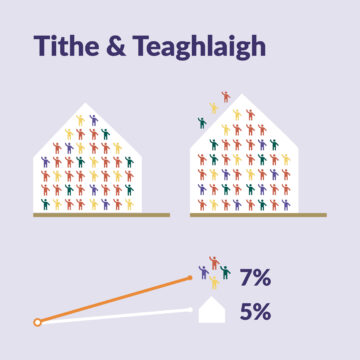New Research on Gaeltacht Population shows the number of families is growing at at a faster rate than the number of houses

The results of new research commissioned into the 2022 Census give an insight into the demand and supply of housing in the Gaeltacht. The main results of the research are:
- The population and number of families in the Gaeltacht is growing at a faster rate than the number of houses, which shows that demand for housing in the Gaeltacht is growing.
- There are 5 times more holiday homes in the Gaeltacht as a share of the overall housing stock than there are in the country as a whole. The largest share of holiday homes is in the Kerry Gaeltacht and the Donegal Gaeltacht. More than 40% of the houses in the Language Planning Areas of South Kerry, Tory Island and North Donegal are holiday homes.
- The percentage of empty houses in the Gaeltacht (11%) is higher than the national average (8%).
- The most common families in the Gaeltacht are those with at least one adult child living at home.
The Economist, Dr. Séin Ó Muineacháin carried out this work on behalf of Údarás na Gaeltachta. A comprehensive report on the results is being published today. This particular research will be important for the work being carried out on the Údarás na Gaeltachta housing initiative, and for the business case which will be presented to the Board of Údarás na Gaeltachta in due course.
Dr. Séin Ó Muineacháin said ‘The housing pattern in the Gaeltacht is different from that of the rest of the country. It’s clear that there is a strong demand for housing in the Gaeltacht. Although the number of houses is increasing there are more holiday homes in the Gaeltacht as a share of the total housing than there are at national level and there is a higher percentage of empty house in the Gaeltacht than there are in the country. In the context also of the aging Gaeltacht population it shows the importance of the housing question to the Gaeltacht and to the Irish language.”
Tomás Ó Síocháin, Príomhfheidhmeannach Údarás na Gaeltachta said “the results of this research show the need to provide housing to people to enable them to settle permanently in the Gaeltacht and that this supply will impact the use of Irish as a community language and therefore the number of pupils in schools. It is evident from this research that there will be a continuous demand for housing for the foreseeable future”.
The Board of Údarás na Gaeltachta approved a housing initiative, supported by a capital allocation of €250,000 on the 15th of December last, towards development and research costs to develop a model of affordable housing for Irish speakers on Údarás lands in Gaeltacht areas. There is ongoing work being carried out on three sites as a first step towards the development of a sustainable model for Gaeltacht areas. Údarás na Gaeltachta is involved in a consultation process with relevant stakeholders, this research forming part of it, which is a standing agenda item for Údarás Board Meetings.
The feasibilities regarding three Údarás sites are currently being examined:
- An Rinn, Co. Waterford
- An Cheathrú Rua, Co. Galway
- Gaoth Dobhair, Co. Donegal
These three sites were chosen following a review of the Údarás na Gaeltachta property portfolio and are in existing communities with access to public services.
Údarás na Gaeltachta is involved with ongoing discussions with local authorities and other relevant stakeholders including Department of Tourism, Culture, Arts, Gaeltacht, Sport and Media and the Department of Housing, Local Government and Heritage to progress the Údarás Housing initiative.
A dedicated email address has been established, tithiocht@udaras.ie, for anyone who would like to receive further information on this issue or regarding the three sites that have been identified at this stage of the project.